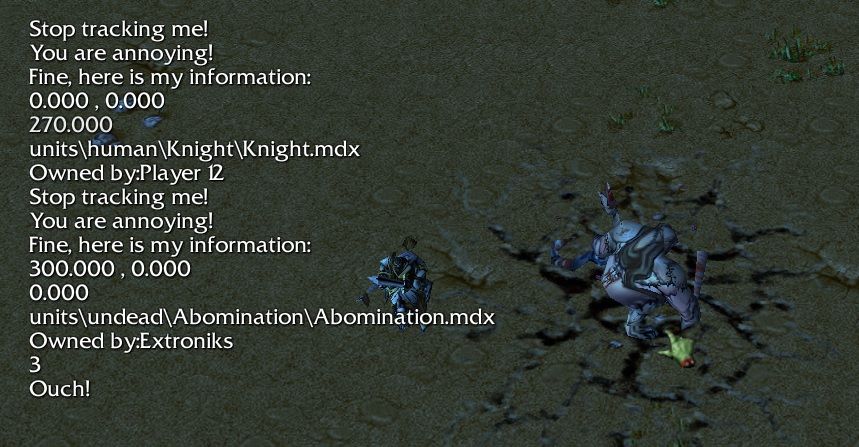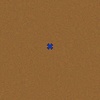-
Are you planning to upload your awesome spell or system to Hive? Please review the rules here.
-
🏆 Texturing Contest #33 is OPEN! Contestants must re-texture a SD unit model found in-game (Warcraft 3 Classic), recreating the unit into a peaceful NPC version. 🔗Click here to enter!
-
It's time for the first HD Modeling Contest of 2024. Join the theme discussion for Hive's HD Modeling Contest #6! Click here to post your idea!
GUITrack v1.3
Haven't really uploaded stuff in ages but here goes an attempt 
Basically a GUI API for trackables, supports player only trackables and as many trackable triggers per trackable as you wish (well within hashtable and integer limtis anyway).
Trackables created without specifying a player default to player 12 but are interactable by everyone.
Dunno if anyone finds this usefull but i couldn't find a general purpose trackable system for GUI users in the spell section so here is one.
vJass users should use Track:
http://www.hiveworkshop.com/forums/jass-resources-412/system-track-205760/index8.html
The test map contains leaks in the example triggers, but they aren't the system itself so if it does become an issue I will fix it.
Pros:
* GUI friendly
* Trackables in GUI
* As much trigger on click / hover as you want
* Player only trackables supported
* Works for multiplayer
Cons:
* Slower than vJass version (obviously )
)
Instructions:
Copy the GTrack VarInit trigger to initialize all variables needed by system (make sure you have this option turned on)
Copy the GTrack API trigger for the system after the variables are initialized.
v1.0 - initial release
v1.1 - small performance boost, added readme, category now only JASS no longer gui
v1.2 - now uses only 1 hashtable, limit of 10000 hit triggers per trackable added as result
v1.3 - updated hashtable keys
Keywords:
track, trackable, gui, system, model, interface, ui
Basically a GUI API for trackables, supports player only trackables and as many trackable triggers per trackable as you wish (well within hashtable and integer limtis anyway).
Trackables created without specifying a player default to player 12 but are interactable by everyone.
Dunno if anyone finds this usefull but i couldn't find a general purpose trackable system for GUI users in the spell section so here is one.
vJass users should use Track:
http://www.hiveworkshop.com/forums/jass-resources-412/system-track-205760/index8.html
The test map contains leaks in the example triggers, but they aren't the system itself so if it does become an issue I will fix it.
Pros:
* GUI friendly
* Trackables in GUI
* As much trigger on click / hover as you want
* Player only trackables supported
* Works for multiplayer
Cons:
* Slower than vJass version (obviously
JASS:
/**************************************************************************************************************
***
*** How to use this?
*** 1. Enable Generate Unknown variables in the File->Preferences->General
*** 2. Copy the GTrack VarInit trigger to your map (this should generate all variables)
*** 3. Copy the GTrack API trigger to your map
*** 4. Use the system as shown in examples
**************************************************************************************************************
***
*** Troubleshooting
***
*** 1. I get errors like "unknown variable udg_XYZ"?
*** All the needed variables haven't been generated, make sure to follow the instructions
***
*** 2. I get errors like "unknown function xyz?"?
*** This usually happens if the library is placed in the wrong order in the trigger treeview. Please perform the following steps:
***
*** Deactivate all triggers that use that function and save the map
*** Make sure that the GTrack API trigger is above all triggers that use the system in your map
*** Now save your map again, exit the World Editor and start it again
*** Re-activate your triggers, they should work now
***
**************************************************************************************************************/
JASS:
function GetTrackableX takes integer trackId returns real
return LoadReal( udg_GTrack_Table, trackId, 0)
endfunction
function GetTrackableY takes integer trackId returns real
return LoadReal( udg_GTrack_Table, trackId, 1)
endfunction
function GetTrackableFacing takes integer trackId returns real
return LoadReal( udg_GTrack_Table, trackId, 2)
endfunction
function GetTrackableModel takes integer trackId returns string
return LoadStr( udg_GTrack_Table, trackId, 3)
endfunction
function GetTrackablePlayer takes integer trackId returns player
if (HaveSavedHandle( udg_GTrack_Table, trackId, 6) ) then
return LoadPlayerHandle( udg_GTrack_Table, trackId, 6)
endif
return Player(15)
endfunction
function AddTrackableHitTrigger takes integer trackId, trigger t returns nothing
local integer i = LoadInteger( udg_GTrack_Table, trackId, 4)
call SaveTriggerHandle( udg_GTrack_Table, trackId, 100+i, t)
call SaveInteger( udg_GTrack_Table, trackId, 4, i+1 )
endfunction
function AddTrackableTrackTrigger takes integer trackId, trigger t returns nothing
local integer i = LoadInteger( udg_GTrack_Table, trackId, 5)
call SaveTriggerHandle( udg_GTrack_Table, trackId, -1-i, t)
call SaveInteger( udg_GTrack_Table, trackId, 5, i+1 )
endfunction
function FlushTrackableTriggers takes integer trackId returns nothing
local real x = LoadReal( udg_GTrack_Table, trackId, 0)
local real y = LoadReal( udg_GTrack_Table, trackId, 1)
local real facing = LoadReal( udg_GTrack_Table, trackId, 2)
local string model = LoadStr(udg_GTrack_Table, trackId, 3)
local player p = LoadPlayerHandle( udg_GTrack_Table, trackId, 6)
call FlushChildHashtable( udg_GTrack_Table, trackId)
call SaveReal( udg_GTrack_Table, trackId, 0, x)
call SaveReal( udg_GTrack_Table, trackId, 1, y)
call SaveReal( udg_GTrack_Table, trackId, 2, facing)
call SaveStr( udg_GTrack_Table, trackId, 3, model)
call SaveInteger( udg_GTrack_Table, trackId, 4, 0)
call SaveInteger( udg_GTrack_Table, trackId, 5, 0)
call SavePlayerHandle( udg_GTrack_Table, trackId, 6, p)
endfunction
function TrackableCreateEx takes player p returns integer
local string model = ""
local trackable t
local integer pkey
if(GetLocalPlayer() == p ) then
set model = udg_GTrack_Model
endif
set t = CreateTrackable( model, udg_GTrack_X, udg_GTrack_Y, udg_GTrack_Facing * bj_DEGTORAD)
set pkey = GetHandleId(t)
call TriggerRegisterTrackableHitEvent( udg_GTrack_HitEvent, t)
call TriggerRegisterTrackableTrackEvent( udg_GTrack_TrackEvent, t)
call SaveReal( udg_GTrack_Table, pkey, 0, udg_GTrack_X)
call SaveReal( udg_GTrack_Table, pkey, 1, udg_GTrack_Y)
call SaveReal( udg_GTrack_Table, pkey, 2, udg_GTrack_Facing)
call SaveStr( udg_GTrack_Table, pkey, 3, udg_GTrack_Model)
call SaveInteger( udg_GTrack_Table, pkey, 4, 0)
call SaveInteger( udg_GTrack_Table, pkey, 5, 0)
call SavePlayerHandle( udg_GTrack_Table, pkey, 6, p)
set t = null
return pkey
endfunction
function TrackableCreate takes nothing returns integer
local trackable t = CreateTrackable( udg_GTrack_Model, udg_GTrack_X, udg_GTrack_Y, udg_GTrack_Facing * bj_DEGTORAD )
local integer pkey = GetHandleId(t)
call TriggerRegisterTrackableHitEvent( udg_GTrack_HitEvent, t)
call TriggerRegisterTrackableTrackEvent( udg_GTrack_TrackEvent, t)
call SaveReal( udg_GTrack_Table, pkey, 0, udg_GTrack_X)
call SaveReal( udg_GTrack_Table, pkey, 1, udg_GTrack_Y)
call SaveReal( udg_GTrack_Table, pkey, 2, udg_GTrack_Facing)
call SaveStr( udg_GTrack_Table, pkey, 3, udg_GTrack_Model)
call SaveInteger( udg_GTrack_Table, pkey, 4, 0)
call SaveInteger( udg_GTrack_Table, pkey, 5, 0)
set t = null
return pkey
endfunction
function TrackableHitEvent takes nothing returns boolean
local trackable t = GetTriggeringTrackable()
local integer i = 0
local integer count
local trigger trig
local integer pkey = GetHandleId(t)
if (HaveSavedInteger( udg_GTrack_Table, pkey, 4 ) ) then
set count = LoadInteger( udg_GTrack_Table, pkey, 4)
loop
exitwhen i >= count
set trig = LoadTriggerHandle( udg_GTrack_Table, pkey, 100+i)
set udg_GTrack_HandleId = pkey
if (TriggerEvaluate(trig)) then
call TriggerExecute(trig)
endif
set i = i +1
endloop
endif
set t = null
return false
endfunction
function TrackableTrackEvent takes nothing returns boolean
local trackable t = GetTriggeringTrackable()
local integer i = 0
local integer count
local trigger trig
local integer pkey = GetHandleId(t)
if (HaveSavedInteger( udg_GTrack_Table, pkey, 5 ) ) then
set count = LoadInteger( udg_GTrack_Table, pkey, 5)
loop
exitwhen i >= count
set trig = LoadTriggerHandle( udg_GTrack_Table, pkey, -1-i)
set udg_GTrack_HandleId = pkey
if (TriggerEvaluate(trig)) then
call TriggerExecute(trig)
endif
set i = i +1
endloop
endif
set t = null
return false
endfunction
function InitTrig_GTrack_API takes nothing returns nothing
set udg_GTrack_Table = InitHashtable()
set udg_GTrack_HitEvent = CreateTrigger()
set udg_GTrack_TrackEvent = CreateTrigger()
call TriggerAddCondition( udg_GTrack_HitEvent, function TrackableHitEvent )
call TriggerAddCondition( udg_GTrack_TrackEvent, function TrackableTrackEvent )
endfunctionInstructions:
Copy the GTrack VarInit trigger to initialize all variables needed by system (make sure you have this option turned on)
Copy the GTrack API trigger for the system after the variables are initialized.
v1.0 - initial release
v1.1 - small performance boost, added readme, category now only JASS no longer gui
v1.2 - now uses only 1 hashtable, limit of 10000 hit triggers per trackable added as result
v1.3 - updated hashtable keys
Keywords:
track, trackable, gui, system, model, interface, ui
Contents
Reviews


 Approved
Approved











